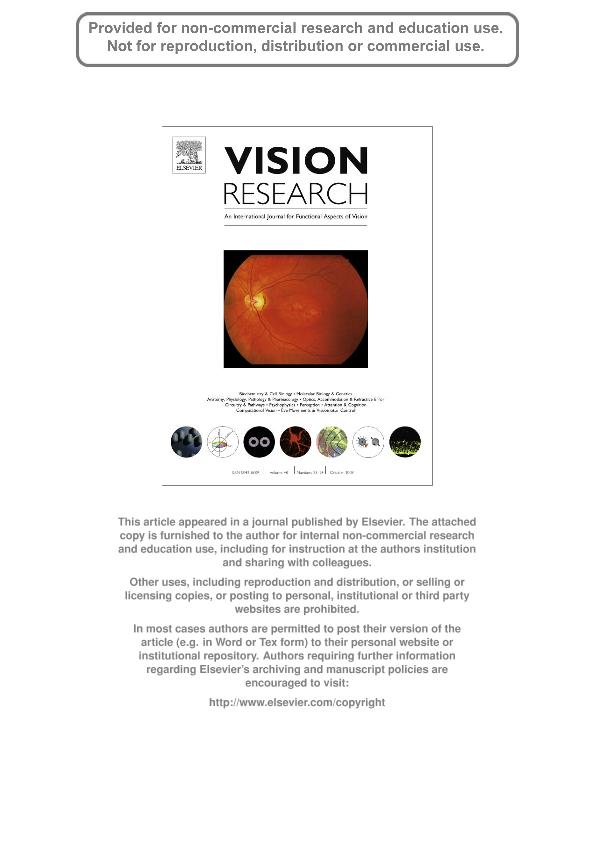Mostrar el registro sencillo del ítem
dc.contributor.author
Barraza, Jose Fernando

dc.contributor.author
Grzywacz, Norberto M.
dc.date.available
2020-05-22T15:41:26Z
dc.date.issued
2008-10
dc.identifier.citation
Barraza, Jose Fernando; Grzywacz, Norberto M.; Speed adaptation as Kalman filtering; Pergamon-Elsevier Science Ltd; Vision Research; 48; 23-24; 10-2008; 2485-2491
dc.identifier.issn
0042-6989
dc.identifier.uri
http://hdl.handle.net/11336/105752
dc.description.abstract
If the purpose of adaptation is to fit sensory systems to different environments, it may implement an optimization of the system. What the optimum is depends on the statistics of these environments. Therefore, the system should update its parameters as the environment changes. A Kalman-filtering strategy performs such an update optimally by combining current estimations of the environment with those from the past. We investigate whether the visual system uses such a strategy for speed adaptation. We performed a matching-speed experiment to evaluate the time course of adaptation to an abrupt velocity change. Experimental results are in agreement with Kalman-modeling predictions for speed adaptation. When subjects adapt to a low speed and it suddenly increases, the time course of adaptation presents two phases, namely, a rapid decrease of perceived speed followed by a slower phase. In contrast, when speed changes from fast to slow, adaptation presents a single phase. In the Kalman-model simulations, this asymmetry is due to the prevalence of low speeds in natural images. However, this asymmetry disappears both experimentally and in simulations when the adapting stimulus is noisy. In both transitions, adaptation now occurs in a single phase. Finally, the model also predicts the change in sensitivity to speed discrimination produced by the adaptation.
dc.format
application/pdf
dc.language.iso
eng
dc.publisher
Pergamon-Elsevier Science Ltd

dc.rights
info:eu-repo/semantics/openAccess
dc.rights.uri
https://creativecommons.org/licenses/by-nc-nd/2.5/ar/
dc.subject
VISUAL MOTION
dc.subject
MOTION ADAPTATION
dc.subject
KALMAN FILTERING
dc.subject
SPEED PERCEPTION
dc.subject
SPEED DISCRIMINATION
dc.subject
BAYESIAN MODEL
dc.subject.classification
Otras Ingenierías y Tecnologías

dc.subject.classification
Otras Ingenierías y Tecnologías

dc.subject.classification
INGENIERÍAS Y TECNOLOGÍAS

dc.title
Speed adaptation as Kalman filtering
dc.type
info:eu-repo/semantics/article
dc.type
info:ar-repo/semantics/artículo
dc.type
info:eu-repo/semantics/publishedVersion
dc.date.updated
2020-03-11T18:33:31Z
dc.identifier.eissn
1878-5646
dc.journal.volume
48
dc.journal.number
23-24
dc.journal.pagination
2485-2491
dc.journal.pais
Estados Unidos

dc.description.fil
Fil: Barraza, Jose Fernando. Consejo Nacional de Investigaciones Científicas y Técnicas. Centro Científico Tecnológico Conicet - Tucumán. Instituto de Investigación en Luz, Ambiente y Visión. Universidad Nacional de Tucumán. Facultad de Ciencias Exactas y Tecnología. Instituto de Investigación en Luz, Ambiente y Visión; Argentina
dc.description.fil
Fil: Grzywacz, Norberto M.. University of Southern California; Estados Unidos
dc.journal.title
Vision Research

dc.relation.alternativeid
info:eu-repo/semantics/altIdentifier/doi/http://dx.doi.org/10.1016/j.visres.2008.08.011
dc.relation.alternativeid
info:eu-repo/semantics/altIdentifier/url/https://www.sciencedirect.com/science/article/pii/S0042698908004173
Archivos asociados
